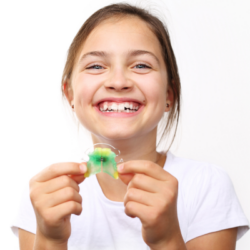As parents, we’re often bombarded with information about our children’s health and development, but one aspect that sometimes gets overlooked is their dental health. Baby teeth, also known as primary teeth, play a crucial role in a child’s overall health and well-being. At Richmond Pediatric Dentistry & Orthodontics, we believe in empowering parents with the knowledge they need to care for their children’s smiles. In this blog, we’ll cover the ABCs of baby teeth, including why they’re important, when they emerge, how to care for them, and what to expect as they transition to permanent teeth.
A is for Anatomy
Baby teeth, also known as primary teeth, are the initial set of teeth that children develop. They typically begin to emerge around six months of age and continue to come in until around age three. By age three, most children have a full set of 20 primary teeth, which serve several important functions:
- Chewing: Baby teeth play a crucial role in chewing and digesting food, allowing children to eat a variety of nutritious foods to support their growth and development.
Speech Development: Baby teeth help children learn to speak clearly by providing support for the lips and tongue and guiding the formation of speech sounds.
Facial Development: Baby teeth help maintain space in the jaw for the permanent teeth to erupt properly and support the development of facial muscles and bones.
Smile Aesthetics: Baby teeth contribute to a child’s smile aesthetics and self-esteem, laying the foundation for healthy dental habits and a lifetime of smiles.
B is for Brushing and Flossing
Good oral hygiene habits are essential for maintaining healthy baby teeth and preventing tooth decay and gum disease. Here are some tips for brushing and flossing your child’s teeth:
- Start Early: Begin cleaning your child’s gums even before their first tooth emerges by gently wiping them with a clean, damp cloth after feedings.
- Use the Right Tools: Once your child’s teeth start to come in, use a soft-bristled toothbrush and a small amount of fluoride toothpaste to brush their teeth twice a day. For children under age three, use a rice-sized amount of toothpaste, and for children ages three to six, use a pea-sized amount.
- Supervise Brushing: Children may not have the dexterity to brush their teeth effectively until around age six or seven, so it’s essential to supervise them and help them brush and floss until they can do it on their own.
- Make it Fun: Turn brushing and flossing into a fun and enjoyable experience by singing songs, playing games, or using a timer to make sure they brush for the recommended two minutes.
C is for Checkups
Routine dental checkups are crucial for upholding your child’s oral health. The American Academy of Pediatric Dentistry recommends that children visit the dentist for their first checkup by age one or within six months of the eruption of their first tooth. During these checkups, the dentist will:
- Examine your child’s teeth, gums, and oral tissues for signs of decay, disease, or other issues.
- Ensure your child’s teeth are clean by removing plaque and tartar buildup.
- Offer guidance on proper oral hygiene, covering brushing, flossing, and diet.
- Monitor your child’s dental development and address any concerns or questions you may have.
D is for Development
Understanding the stages of dental development can help parents know what to expect as their child grows and matures. Here’s a brief overview of the stages of dental development:
- Eruption: Baby teeth typically begin to emerge around six months of age, starting with the lower front teeth (lower central incisors) followed by the upper front teeth (upper central incisors). The remaining teeth erupt in a specific sequence over the next few years, with the full set of 20 primary teeth usually present by age three.
- Shedding: As children grow and their jaws expand, the primary teeth gradually loosen and fall out to make way for the permanent teeth. This process typically begins around age six and continues until around age 12 or 13, when the last baby teeth are lost.
- Transition: The transition from baby teeth to permanent teeth can be an exciting and sometimes challenging time for children. It’s essential to provide support and encouragement as they navigate this milestone and adjust to their new smile.
Request Your Appointment Today
Baby teeth may be small, but they play a significant role in a child’s overall health and development. By understanding the ABCs of baby teeth and taking proactive steps to care for them, parents can help set their children up for a lifetime of healthy smiles. At Richmond Pediatric Dentistry & Orthodontics, we’re here to support you every step of the way on your child’s dental journey. If you have any questions or concerns about your child’s oral health, don’t hesitate to request an appointment. Together, we can ensure that your child’s smile shines bright from A to Z.



